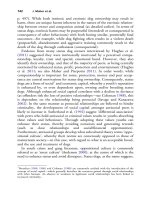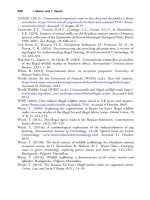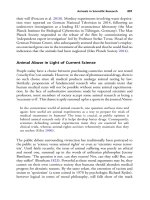The palgrave international handbook of a 151
Bạn đang xem bản rút gọn của tài liệu. Xem và tải ngay bản đầy đủ của tài liệu tại đây (26.88 KB, 1 trang )
142
J. Maher et al.
p. 497). While both intrinsic and extrinsic dog ownership may result in
harm, there are unique harms inherent in the nature of the extrinsic relationship between owner and companion animal (as detailed earlier). In terms of
status dogs, extrinsic harms may be purposeful (intended) or consequential (a
consequence of other behaviours) with both having similar, potentially fatal
outcomes—for example, while dog fighting often results in a violent death
(purposeful), abandonment and aggressive training commonly result in the
death of the dog through euthanasia (consequential).
Evidence from many status dog owners interviewed by Hughes et al.
(2011) suggested they were intrinsically motivated by a perceived companionship, loyalty, trust and special, emotional bond. However, they also
identify their ownership, and that of the majority of peers, as being centrally
motivated by enhanced status, profit, protection and entertainment (Hughes
et al. 2011; see also Maher and Pierpoint 2011). In order words, while
companionship is important for some, protection, money and peer acceptance are central motivations for status dog ownership. Consequently, status
dogs are a form of social7 and economic capital, whereby a youth’s reputation
is enhanced by, or even dependent upon, owning and/or breeding status
dogs. Although enhanced social capital correlates with a decline in deviance
(as offenders risk the loss of positive relationships—see Coleman 1988), this
is dependent on the relationship being prosocial (Savage and Kanazawa
2002). In the same manner as prosocial relationships are believed to hinder
criminality, the development of social capital amongst antisocial peers is
likely to increase it. Sutherland et al. (1992) suggest ‘differential association’
with peers who hold antisocial or criminal values results in youths absorbing
these values and behaviours. Through adopting these values youths can
enhance their status, thereby avoiding ostracism and generating rewards
(such as close relationships and social/financial opportunities).
Furthermore, antisocial groups develop what subcultural theory terms ‘oppositional culture’, whereby their norms are consciously opposed to those of
mainstream society—in this case, with regard to what is an acceptable breed,
and the use and treatment of dogs.
In youth crime and gang literature, oppositional culture is commonly
referred to as ‘street culture’ (Anderson 2000), at the centre of which is the
need to enhance status and avoid disrespect. Status dogs, as the name suggests,
7
Bourdieu (1980, 1986) and Coleman (1988) are commonly credited with the introduction of the
concept of social capital—which generally describes the resources gained through social relationships
with other humans. An absence or weakness in legitimate social relationships has been linked to
increased criminality.









